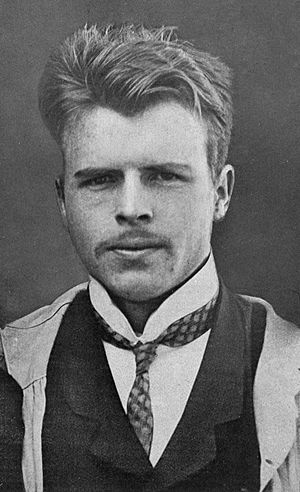Hermann Rorschach facts for kids
Quick facts for kids
Hermann Rorschach
|
|
|---|---|

Rorschach in 1910
|
|
| Born | 8 November 1884 |
| Died | 2 April 1922 (aged 37) Herisau, Appenzell AR, Switzerland
|
| Nationality | Swiss |
| Known for | Rorschach test |
| Spouse(s) | Olga Stempelin (m. 1913–22; his death) |
| Children | 2 |
| Scientific career | |
| Fields | Psychiatry, psychometrics |
| Influences | Eugen Bleuler |
Hermann Rorschach (born November 8, 1884 – died April 2, 1922) was a Swiss doctor who studied the mind. He was a psychiatrist and a psychoanalyst. He loved art, and this helped him create a special test using inkblots. This test was designed to understand different parts of a person's mind.
His method is now known as the Rorschach test. People still use versions of this test today. It helps to identify personality traits and some mental health conditions. Rorschach kept working on his test until he passed away at age 37.
Early Life and Inkblots
Hermann Rorschach was born in Zürich, Switzerland. He was the oldest of three children. His parents were Ulrich and Philippine Rorschach. He had a sister named Anna and a brother named Paul.
Hermann spent his childhood in Schaffhausen, in northern Switzerland. His school friends called him Klex, which means "inkblot." This was because he enjoyed making pictures from inkblots. This hobby is called klecksography.
People had thought about inkblots before Rorschach. For example, in 1857, a German doctor named Justinus Kerner published a book of poems. Each poem was inspired by an accidental inkblot. It is thought that Rorschach might have known about this book. A French psychologist, Alfred Binet, also used inkblots to test creativity.
Hermann's father was an art teacher. He encouraged Hermann to be creative through painting and drawing. As Hermann finished high school, he was unsure what to study. He couldn't decide between a career in art or in science. He wrote to a German biologist, Ernst Haeckel, for advice. A big reason Hermann chose science was that his father died while he was still deciding.
Education and Career Path
In his early years, Rorschach went to Schaffhausen Cantonal School. He was a very smart student. He often helped other students with their studies. After Ernst Haeckel suggested a science career, Rorschach studied geology and botany. This was at Académie de Neuchâtel in 1904.
After one term, he moved to the Université de Dijon. There he took French classes. In the same year, he started medical school at the University of Zurich. While studying, Rorschach began learning Russian. In 1906, he traveled to Russia for a holiday.
Traveling was a big part of his life after medical school. In Dijon, he met a man who taught him about Russian culture. He was torn between staying in Switzerland or moving to Russia. He eventually took a job as an assistant at a mental hospital.
While working, Rorschach finished his doctor's paper in 1912. His teacher was the psychiatrist Eugen Bleuler. Bleuler had also taught Carl Jung. The new ideas about psychoanalysis reminded Rorschach of his childhood inkblots. He wondered why people saw different things in the same inkblots. While still a student, he started showing inkblots to schoolchildren. He then studied their answers. This early work led to his famous ink blot experiment.
Rorschach remained very interested in Russian culture. In 1913, he got a special chance to study in Russia. He continued to learn about modern ways of studying the mind. He spent time in a village near Moscow. In 1914, he came back to Switzerland. He worked at the Waldau University Hospital in Bern. In 1915, Rorschach became an assistant director. This was at the psychiatric hospital in Herisau. In 1921, he wrote his book Psychodiagnostik. This book became the foundation for his inkblot test.
Family Life
Rorschach finished medical school in Zurich in 1909. At the same time, he got engaged to Olga Stempelin. She was from Kazan, in present-day Tatarstan, Russia. They got married in 1913. The couple lived in Russia until 1915. Then they moved back to Switzerland for Rorschach's work.
They had two children. Their daughter, Elizabeth (called "Lisa"), was born in 1917. Their son, Ulrich Wadin (called "Wadim"), was born in 1919. Neither Lisa nor Wadim had children.
Hermann Rorschach died one year after writing his book Psychodiagnostik. He passed away from an infection in his stomach. This was likely caused by a burst appendix. He was still the associate director of the Herisau Hospital when he died. He was only 37 years old.
Rorschach's Legacy
In 2001, some people criticized the inkblot test. They said it was not truly scientific. Scientific American magazine called its use controversial. This was because different psychologists sometimes got different results from the same data. This suggested the results might be based on opinion, not facts.
However, in 2013 and 2015, new studies were published. These studies looked at many different research papers. Their findings helped to remove the criticism that the test was not scientific.
In November 2013, Google celebrated Rorschach's 129th birthday. They made a special Google Doodle showing an interpretation of his inkblot test. The Rorschach Inkblot Method has led to a lot of research. Only the MMPI has more published studies among personality tests.
The cover of a book by Sigmund Freud shows artwork based on a Rorschach Inkblot. This book is called The Essentials of Psycho-analysis. It was published in 2005.
See also
 In Spanish: Hermann Rorschach para niños
In Spanish: Hermann Rorschach para niños
- Emil Oberholzer


